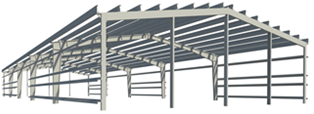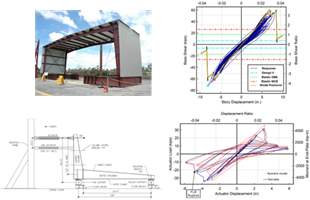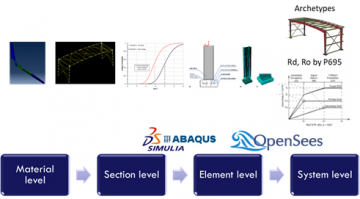Metal building systems (MBS) are a pre-engineered solution broadly adopted for low-rise buildings with long spans. MBS are fast to erect and have low maintenance cost while covering large areas that can fit diverse types of use. Its primary structural system is composed of transversal steel frames with thin walled tapered beams and columns. The members are designed to optimize steel consumption thus the cross-sections are larger only where internal forces are higher. As a result, most of MBS built in Canada are composed of non-compact structural members, therefore they are not a pre-qualified seismic force resisting system (SFRS) according to the National Building Code of Canada (NBCC). Currently, there is no consistent methodology for seismic design of MBS in Canada. Designers usually approach this problem using external guidance based on ASCE-7 using slender elements and assuming that the building is an Ordinary Moment Frame (OMF). Nevertheless, the MBS yielding mechanism is not the same as a typical OMF.

These gaps in code provisions, design methodology and expected structural behavior are compromising the usage of MBS in seismic zones in both Canada and United States. Therefore, research on MBS seismic behavior is relevant for both regulatory agencies and MBS manufacturing companies. This research already started and, even though major advances were made over the last 10 years, the seismic performance of MBS is still not fully understood. The current challenge in MBS seismic research is the seismic performance assessment for design purposes.

In this project, MBS is investigated through state-of-art numerical simulations in the role of being a Seismic Force Resisting System (SFRS). This system is an alternative to the costly MRF (DSMRF, MDSMRF and LDSMRF) which are currently required by code for regions with elevated earthquake hazard in Canada. For that, numeric tools are being developed to assess element level and system level response of MBS. Finite element models are calibrated using data available from previous tests to replicate complex response of slender tapered elements under cyclic loading protocol. Additional finite element models are being developed to simulate the base connection response.

With the complete understanding of nonlinear response of tapered elements and base connections, an effective design methodology can be developed. Equations are proposed for assessing the energy dissipating devices and capacity design assumptions are adopted for designing other members that are to remain damage free through an eventual earthquake event. Proposed design assumptions are then used to develop a representative set of MBS Archetypes. State-of-art procedure is used evaluate the seismic performance of the Archetypes with iterative incremental dynamic analysis and collapse assessment. By the end of this part, proposed MBS seismic design guidelines will have its performance fully understood and ready for implementation together with industry members.
Acknowledgement
This work is being conduced by Fabrício Bagatini-Cachuço under the supervision of Prof. Tony Yang.